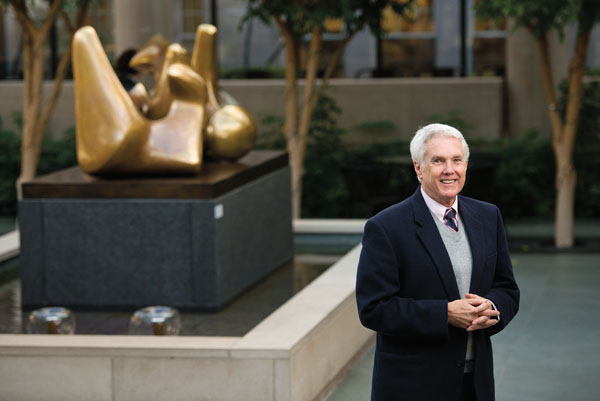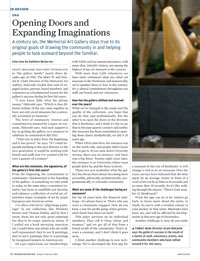In Review
 FAMILY MAN: Director Grant Holcomb says the gallery’s success is the result of a family of staff, volunteers, artists, and community members who have rallied around it for 100 years. (Photo: Adam Fenster)
FAMILY MAN: Director Grant Holcomb says the gallery’s success is the result of a family of staff, volunteers, artists, and community members who have rallied around it for 100 years. (Photo: Adam Fenster)Grant Holcomb was first introduced to “the gallery family” nearly three decades ago, in 1985. The Mary W. and Donald R. Clark Director of the Memorial Art Gallery, Holcomb credits that web of engaged artists, patrons, board members, and volunteers as a fundamental reason for the gallery’s success during its first 100 years.
“I now know fully what the phrase means,” Holcomb says. “Which is that different entities of the city come together to have, not only an art museum, but a nationally acclaimed art museum.”
The level of community interest and commitment is unusual for a major art museum, Holcomb says. And such support is key to guiding the gallery as it prepares to celebrate its centennial in fall 2013.
“That was in place from the beginning, and it has grown,” he says. “If I could bequeath anything to the next director, or the next generation, it would be working with boards and staffs that I’ve worked with for over a quarter of a century.”
What are the constants, the signatures, of the gallery’s first 100 years?
From the beginning, the commitment to community—fundamental to the founding of the gallery—is something we take pride in today. At the same time, a consistent initiative has been to establish and develop and enhance a collection of world art, oftentimes major examples of art by major European and American artists. I’ve often referred to “pilgrimage paintings” in our collection, like Winslow Homer and Thomas Eakins, and by that I mean, these are not only great paintings but they’re by major American artists. If I pulled out a book surveying American art, I could show you artists who are really well represented: they’re not B paintings, they’re not C paintings, they’re A paintings by recognized masters in American art. On a per capita basis, our memberships, with 5,000, and our annual attendance, with more than 240,000 visitors, are among the highest of any art museum in the country. With more than 1,100 volunteers, we have more volunteers than any other art museum in the Northeast, and numerically, we’re number three or four in the country. It’s a shared commitment throughout our staff, our board, and our volunteers.
How has the gallery shifted and evolved over the years?
What we’ve changed is the scope and the quality of the collection—you hope that you do that, just professionally. But the other is to open the doors to the diversity that is Rochester, and I think it’s fair to say that in the past quarter century and earlier, this museum has been committed to opening those doors. Symbolically, we did it 25 years ago. When I first came here, the entrance was on the north side, and people didn’t know how to get in. If you came down University Avenue, there was no entrance—and there was a big fence. Twenty-eight years later, the entrance is on University, where most people drive by, and the fence is down. Those two acts symbolize what the gallery has always been about: becoming more accessible, physically, architecturally, programmatically, to a broader community.
What are some of the challenges facing art museums?
For my 28 years here, the financial challenge—it’s always been so. That’s why you want a community engaged. How do you keep a not-for-profit going when government funds have been cut back? This place survives on its individual members. They call it “time, talent, and treasure,” and we get all of that from a broad swath of the community. That’s always a constant, and I don’t think it goes away. I think another challenge is new technology. We’ve developed the first app for a museum in the city of Rochester. It will change a visit to an art museum. Over the years, surveys have indicated that the time spent by an average visitor in front of a work of art can be as little as 10 seconds and no more than 35 seconds. So it’s like walking through the airport. “There’s Gate number 12: Rembrandt.” What the app can do is let visitors go back, to know more about the artist, in depth. So you’re with a resident scholar in your pocket, in that sense. Museums have been, are, and will be affected by developments in this new age of electronics. Another challenge is, how do you make an art museum a cloister for contemplation and insight and beauty, and at the same time impact lives that are so diverse? How do you make the gallery accessible? To move into other lives, other cultures—that’s what an art museum can do.
How does the new Centennial Sculpture Park fit into that vision?
The sculpture park reflects our commitment to community by opening up the grounds, taking down the fence, creating a park that you can walk through or sit in, read a book, play a guitar, have a wedding. At the same time, it honors not only nationally and internationally recognized artists but also those artists who work in this area who are also of that stature. So again it reflects Rochester, quality of art, and the significance of the artistic experience—inside and out now.
What about plans with the University?
The gallery will be much more integrated in programs at the University, as well as programs at other Rochester schools. There’s an interest on all sides in finding good, creative, supportive ways that are good for students and good for the art museum. There’s a wealth of talent at the University, and we have a wonderful collection here. There’s material culture here that is at their disposal for study. So I see a new movement for the gallery, not away from the community, but in a richer way integrated with the academic mission of the University.
How do you balance being a place of memory, engaging with a changing community, and adapting to new technologies?
It’s a great challenge. There was a school group here once, and because of the weather, they had their lunch in the ballroom. And there was this little fellow, probably in first grade, looking around. He’d never been here before, and was just looking around, at the architecture, the space, the scale. And he said, “Is this where the king lives?” Art museums offer an expansion of the imagination, of what’s possible, and where people are at this particular time. You honor that sense of history and memory, hoping both together stimulate the imagination and take, in this case, this young fellow, into new areas of life. At the same time, you’re looking for technologies that help you do that. So you don’t want to destroy one in order to have the other. You want to take the best of both and integrate them when appropriate.
To learn more about the gallery’s centennial and the events it has planned, visit http://mag.rochester.edu/centennial/.

